A Comparative Study of Transformational Leadership and LMX Theory
VerifiedAdded on 2023/04/26
|10
|2438
|350
Essay
AI Summary
This essay provides a comparative analysis of transformational leadership and leader-member exchange (LMX) theory. It begins by defining transformational leadership, highlighting its emphasis on visionary leadership, inspiration, risk-taking, and creative thinking, along with the importance of inspirational motivation, idealized influence, individualized consideration, and intellectual stimulation. The essay then discusses LMX theory, focusing on the dyadic relationships between leaders and followers, the quality of these relationships based on obligation, respect, trust, loyalty, and support, and the three stages of relationship development: role-taking, role-making, and routinization. The comparison explores similarities such as the emphasis on communication and differences including LMX's focus on individual relationships versus transformational leadership's management of environmental uncertainty. The essay concludes by noting the strengths and weaknesses of both theories, including transformational leadership's complexity and potential for manipulation, and LMX's potential for bias and partial judgment, while highlighting the real-world applicability of both leadership styles in modern business.
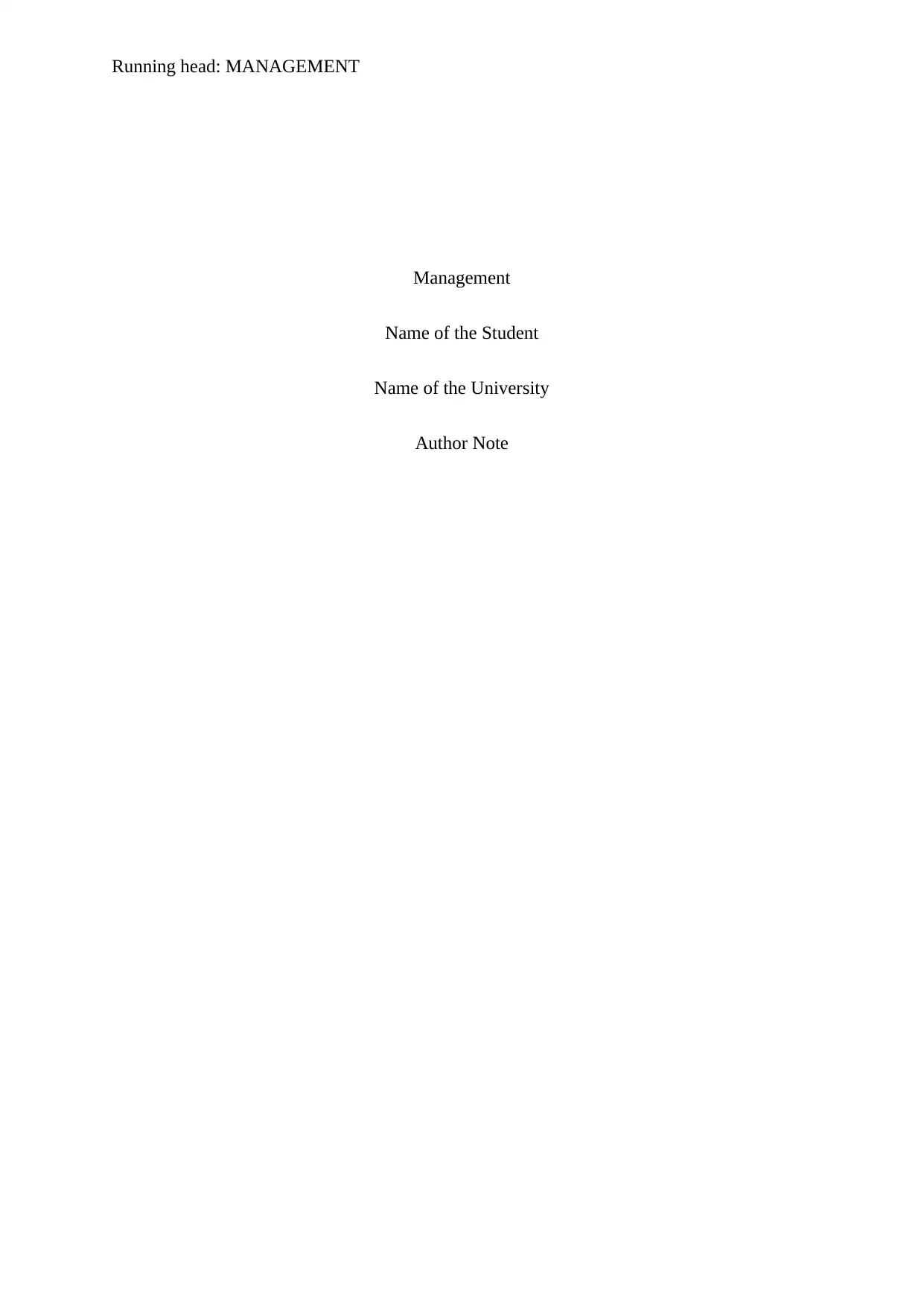
Running head: MANAGEMENT
Management
Name of the Student
Name of the University
Author Note
Management
Name of the Student
Name of the University
Author Note
Paraphrase This Document
Need a fresh take? Get an instant paraphrase of this document with our AI Paraphraser
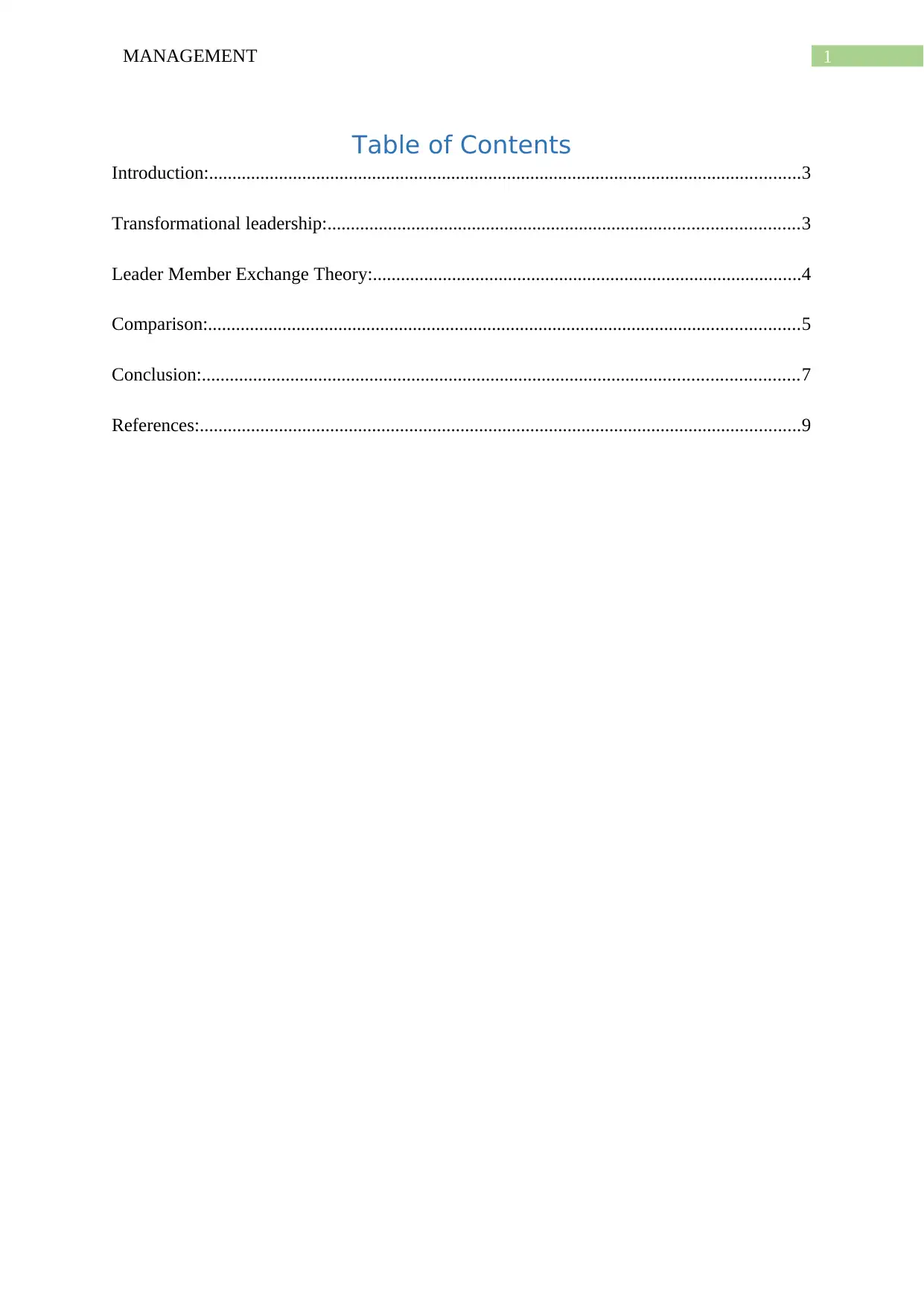
1MANAGEMENT
Table of Contents
Introduction:...............................................................................................................................3
Transformational leadership:.....................................................................................................3
Leader Member Exchange Theory:............................................................................................4
Comparison:...............................................................................................................................5
Conclusion:................................................................................................................................7
References:.................................................................................................................................9
Table of Contents
Introduction:...............................................................................................................................3
Transformational leadership:.....................................................................................................3
Leader Member Exchange Theory:............................................................................................4
Comparison:...............................................................................................................................5
Conclusion:................................................................................................................................7
References:.................................................................................................................................9
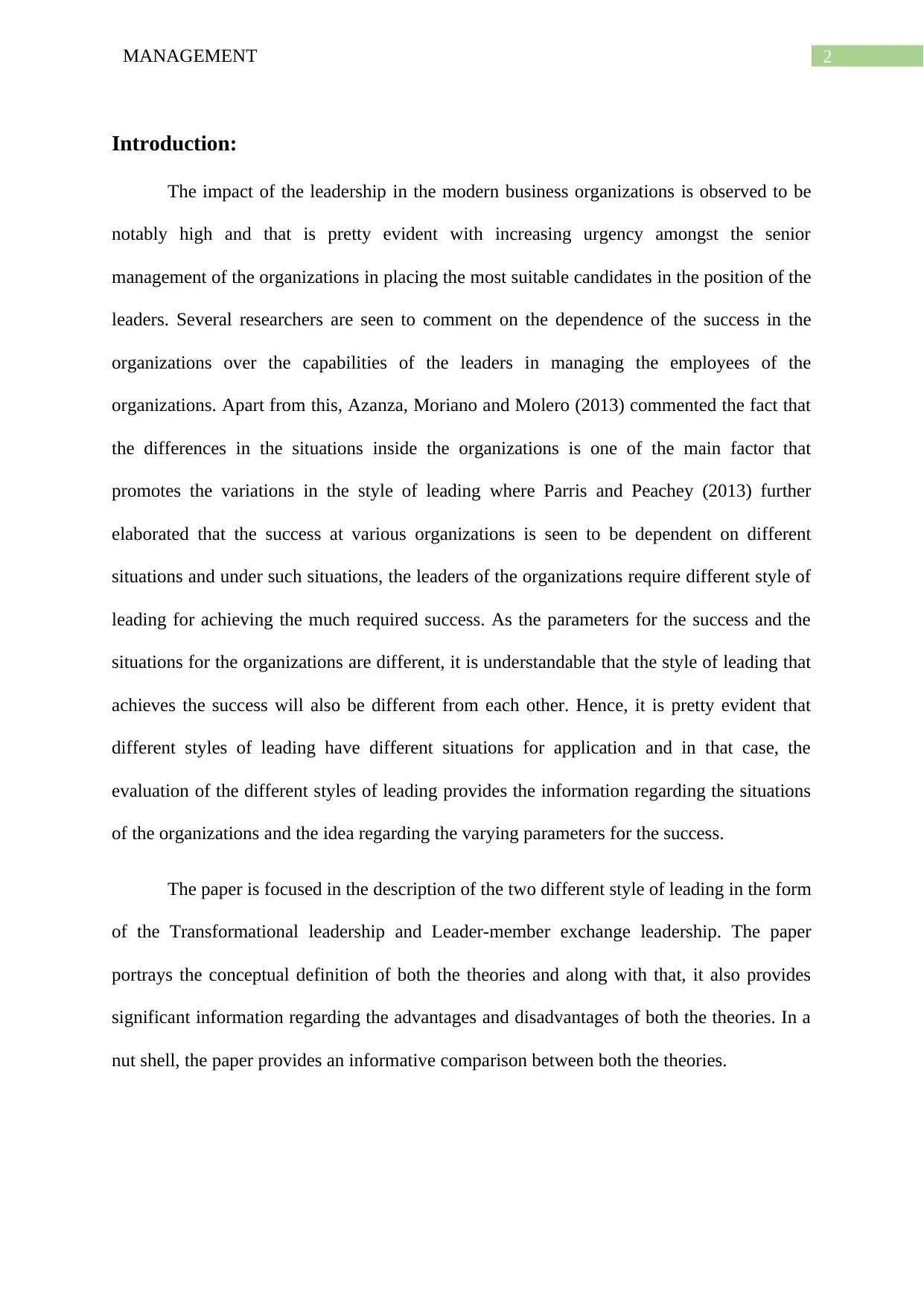
2MANAGEMENT
Introduction:
The impact of the leadership in the modern business organizations is observed to be
notably high and that is pretty evident with increasing urgency amongst the senior
management of the organizations in placing the most suitable candidates in the position of the
leaders. Several researchers are seen to comment on the dependence of the success in the
organizations over the capabilities of the leaders in managing the employees of the
organizations. Apart from this, Azanza, Moriano and Molero (2013) commented the fact that
the differences in the situations inside the organizations is one of the main factor that
promotes the variations in the style of leading where Parris and Peachey (2013) further
elaborated that the success at various organizations is seen to be dependent on different
situations and under such situations, the leaders of the organizations require different style of
leading for achieving the much required success. As the parameters for the success and the
situations for the organizations are different, it is understandable that the style of leading that
achieves the success will also be different from each other. Hence, it is pretty evident that
different styles of leading have different situations for application and in that case, the
evaluation of the different styles of leading provides the information regarding the situations
of the organizations and the idea regarding the varying parameters for the success.
The paper is focused in the description of the two different style of leading in the form
of the Transformational leadership and Leader-member exchange leadership. The paper
portrays the conceptual definition of both the theories and along with that, it also provides
significant information regarding the advantages and disadvantages of both the theories. In a
nut shell, the paper provides an informative comparison between both the theories.
Introduction:
The impact of the leadership in the modern business organizations is observed to be
notably high and that is pretty evident with increasing urgency amongst the senior
management of the organizations in placing the most suitable candidates in the position of the
leaders. Several researchers are seen to comment on the dependence of the success in the
organizations over the capabilities of the leaders in managing the employees of the
organizations. Apart from this, Azanza, Moriano and Molero (2013) commented the fact that
the differences in the situations inside the organizations is one of the main factor that
promotes the variations in the style of leading where Parris and Peachey (2013) further
elaborated that the success at various organizations is seen to be dependent on different
situations and under such situations, the leaders of the organizations require different style of
leading for achieving the much required success. As the parameters for the success and the
situations for the organizations are different, it is understandable that the style of leading that
achieves the success will also be different from each other. Hence, it is pretty evident that
different styles of leading have different situations for application and in that case, the
evaluation of the different styles of leading provides the information regarding the situations
of the organizations and the idea regarding the varying parameters for the success.
The paper is focused in the description of the two different style of leading in the form
of the Transformational leadership and Leader-member exchange leadership. The paper
portrays the conceptual definition of both the theories and along with that, it also provides
significant information regarding the advantages and disadvantages of both the theories. In a
nut shell, the paper provides an informative comparison between both the theories.
⊘ This is a preview!⊘
Do you want full access?
Subscribe today to unlock all pages.

Trusted by 1+ million students worldwide
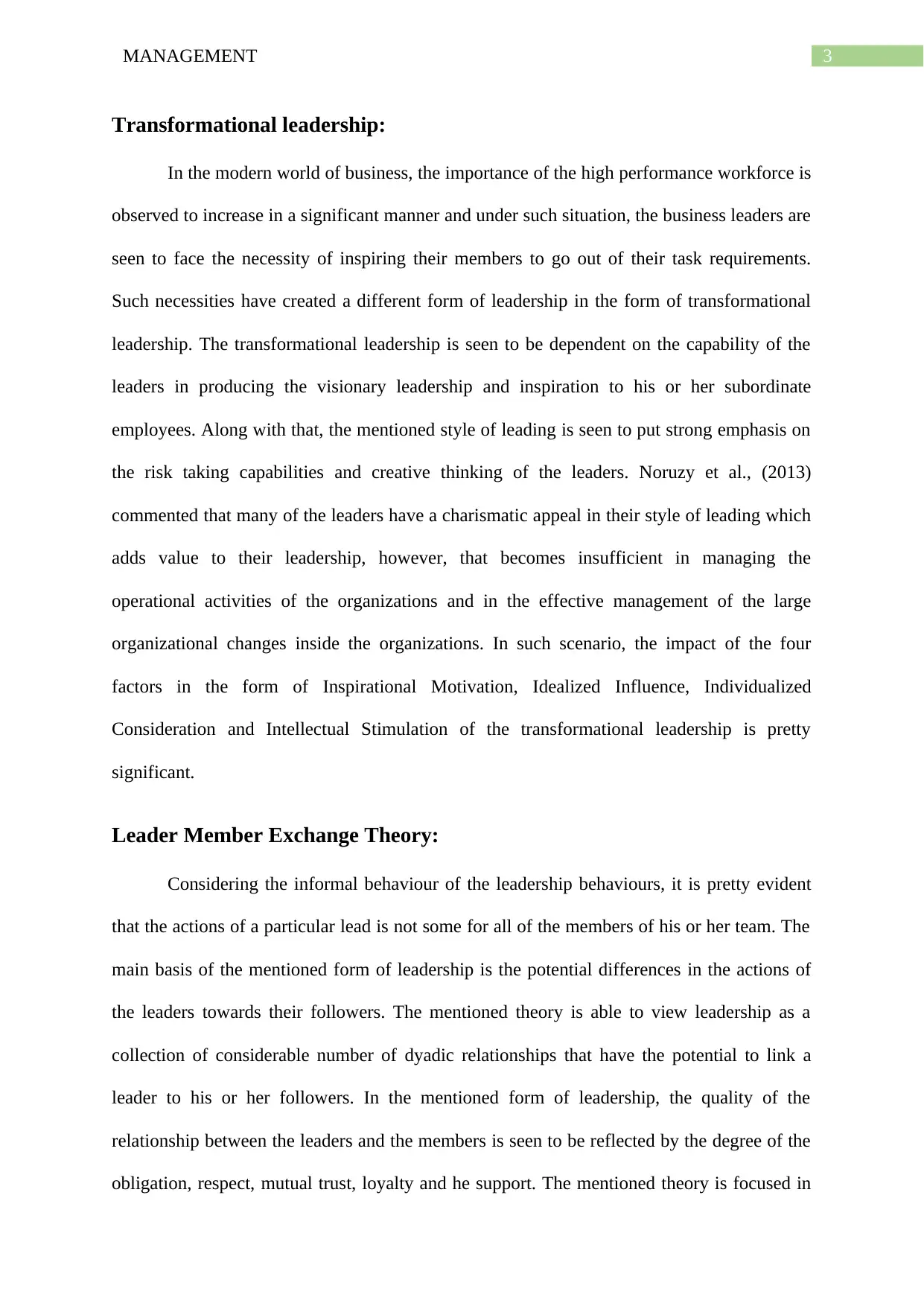
3MANAGEMENT
Transformational leadership:
In the modern world of business, the importance of the high performance workforce is
observed to increase in a significant manner and under such situation, the business leaders are
seen to face the necessity of inspiring their members to go out of their task requirements.
Such necessities have created a different form of leadership in the form of transformational
leadership. The transformational leadership is seen to be dependent on the capability of the
leaders in producing the visionary leadership and inspiration to his or her subordinate
employees. Along with that, the mentioned style of leading is seen to put strong emphasis on
the risk taking capabilities and creative thinking of the leaders. Noruzy et al., (2013)
commented that many of the leaders have a charismatic appeal in their style of leading which
adds value to their leadership, however, that becomes insufficient in managing the
operational activities of the organizations and in the effective management of the large
organizational changes inside the organizations. In such scenario, the impact of the four
factors in the form of Inspirational Motivation, Idealized Influence, Individualized
Consideration and Intellectual Stimulation of the transformational leadership is pretty
significant.
Leader Member Exchange Theory:
Considering the informal behaviour of the leadership behaviours, it is pretty evident
that the actions of a particular lead is not some for all of the members of his or her team. The
main basis of the mentioned form of leadership is the potential differences in the actions of
the leaders towards their followers. The mentioned theory is able to view leadership as a
collection of considerable number of dyadic relationships that have the potential to link a
leader to his or her followers. In the mentioned form of leadership, the quality of the
relationship between the leaders and the members is seen to be reflected by the degree of the
obligation, respect, mutual trust, loyalty and he support. The mentioned theory is focused in
Transformational leadership:
In the modern world of business, the importance of the high performance workforce is
observed to increase in a significant manner and under such situation, the business leaders are
seen to face the necessity of inspiring their members to go out of their task requirements.
Such necessities have created a different form of leadership in the form of transformational
leadership. The transformational leadership is seen to be dependent on the capability of the
leaders in producing the visionary leadership and inspiration to his or her subordinate
employees. Along with that, the mentioned style of leading is seen to put strong emphasis on
the risk taking capabilities and creative thinking of the leaders. Noruzy et al., (2013)
commented that many of the leaders have a charismatic appeal in their style of leading which
adds value to their leadership, however, that becomes insufficient in managing the
operational activities of the organizations and in the effective management of the large
organizational changes inside the organizations. In such scenario, the impact of the four
factors in the form of Inspirational Motivation, Idealized Influence, Individualized
Consideration and Intellectual Stimulation of the transformational leadership is pretty
significant.
Leader Member Exchange Theory:
Considering the informal behaviour of the leadership behaviours, it is pretty evident
that the actions of a particular lead is not some for all of the members of his or her team. The
main basis of the mentioned form of leadership is the potential differences in the actions of
the leaders towards their followers. The mentioned theory is able to view leadership as a
collection of considerable number of dyadic relationships that have the potential to link a
leader to his or her followers. In the mentioned form of leadership, the quality of the
relationship between the leaders and the members is seen to be reflected by the degree of the
obligation, respect, mutual trust, loyalty and he support. The mentioned theory is focused in
Paraphrase This Document
Need a fresh take? Get an instant paraphrase of this document with our AI Paraphraser
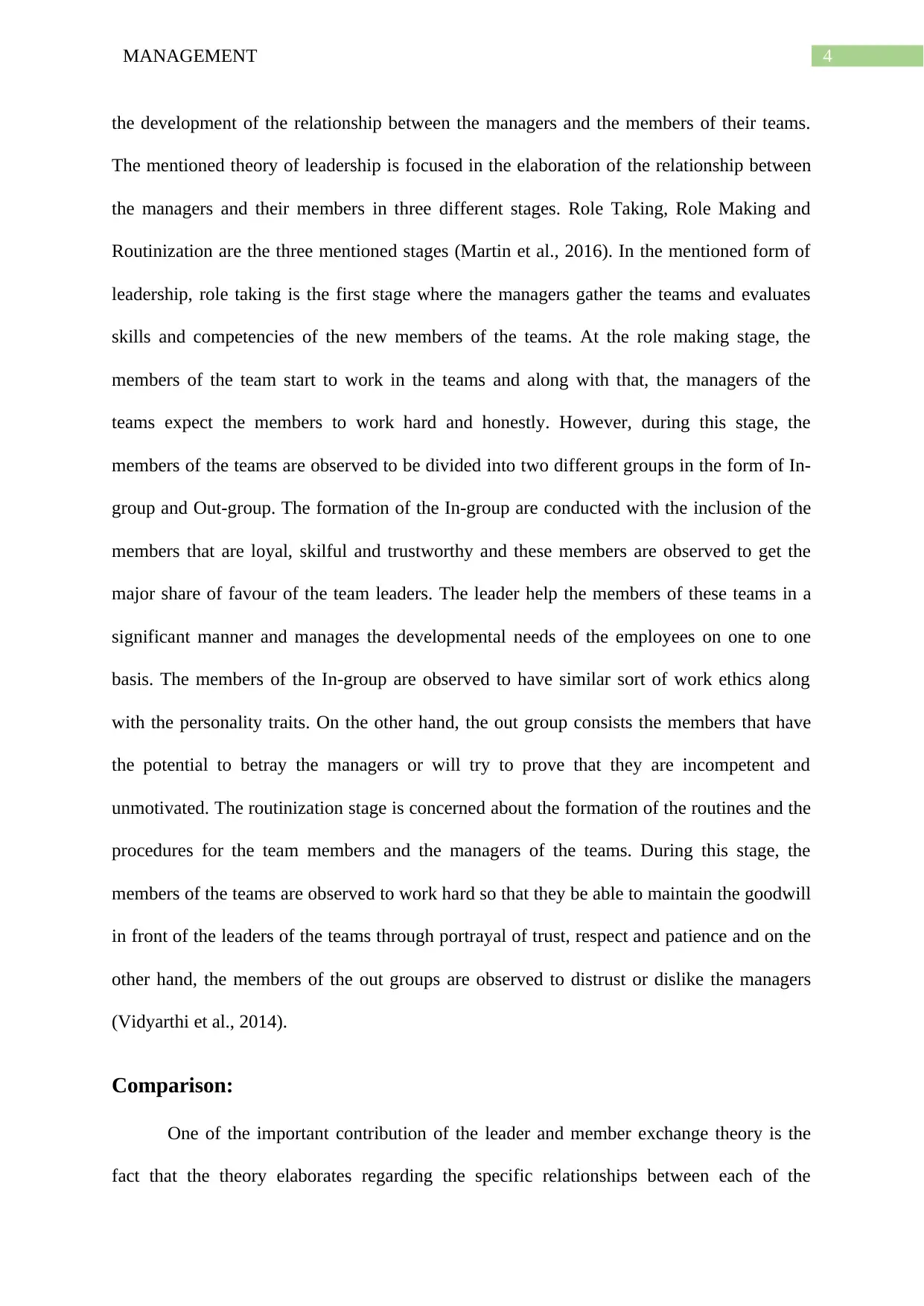
4MANAGEMENT
the development of the relationship between the managers and the members of their teams.
The mentioned theory of leadership is focused in the elaboration of the relationship between
the managers and their members in three different stages. Role Taking, Role Making and
Routinization are the three mentioned stages (Martin et al., 2016). In the mentioned form of
leadership, role taking is the first stage where the managers gather the teams and evaluates
skills and competencies of the new members of the teams. At the role making stage, the
members of the team start to work in the teams and along with that, the managers of the
teams expect the members to work hard and honestly. However, during this stage, the
members of the teams are observed to be divided into two different groups in the form of In-
group and Out-group. The formation of the In-group are conducted with the inclusion of the
members that are loyal, skilful and trustworthy and these members are observed to get the
major share of favour of the team leaders. The leader help the members of these teams in a
significant manner and manages the developmental needs of the employees on one to one
basis. The members of the In-group are observed to have similar sort of work ethics along
with the personality traits. On the other hand, the out group consists the members that have
the potential to betray the managers or will try to prove that they are incompetent and
unmotivated. The routinization stage is concerned about the formation of the routines and the
procedures for the team members and the managers of the teams. During this stage, the
members of the teams are observed to work hard so that they be able to maintain the goodwill
in front of the leaders of the teams through portrayal of trust, respect and patience and on the
other hand, the members of the out groups are observed to distrust or dislike the managers
(Vidyarthi et al., 2014).
Comparison:
One of the important contribution of the leader and member exchange theory is the
fact that the theory elaborates regarding the specific relationships between each of the
the development of the relationship between the managers and the members of their teams.
The mentioned theory of leadership is focused in the elaboration of the relationship between
the managers and their members in three different stages. Role Taking, Role Making and
Routinization are the three mentioned stages (Martin et al., 2016). In the mentioned form of
leadership, role taking is the first stage where the managers gather the teams and evaluates
skills and competencies of the new members of the teams. At the role making stage, the
members of the team start to work in the teams and along with that, the managers of the
teams expect the members to work hard and honestly. However, during this stage, the
members of the teams are observed to be divided into two different groups in the form of In-
group and Out-group. The formation of the In-group are conducted with the inclusion of the
members that are loyal, skilful and trustworthy and these members are observed to get the
major share of favour of the team leaders. The leader help the members of these teams in a
significant manner and manages the developmental needs of the employees on one to one
basis. The members of the In-group are observed to have similar sort of work ethics along
with the personality traits. On the other hand, the out group consists the members that have
the potential to betray the managers or will try to prove that they are incompetent and
unmotivated. The routinization stage is concerned about the formation of the routines and the
procedures for the team members and the managers of the teams. During this stage, the
members of the teams are observed to work hard so that they be able to maintain the goodwill
in front of the leaders of the teams through portrayal of trust, respect and patience and on the
other hand, the members of the out groups are observed to distrust or dislike the managers
(Vidyarthi et al., 2014).
Comparison:
One of the important contribution of the leader and member exchange theory is the
fact that the theory elaborates regarding the specific relationships between each of the
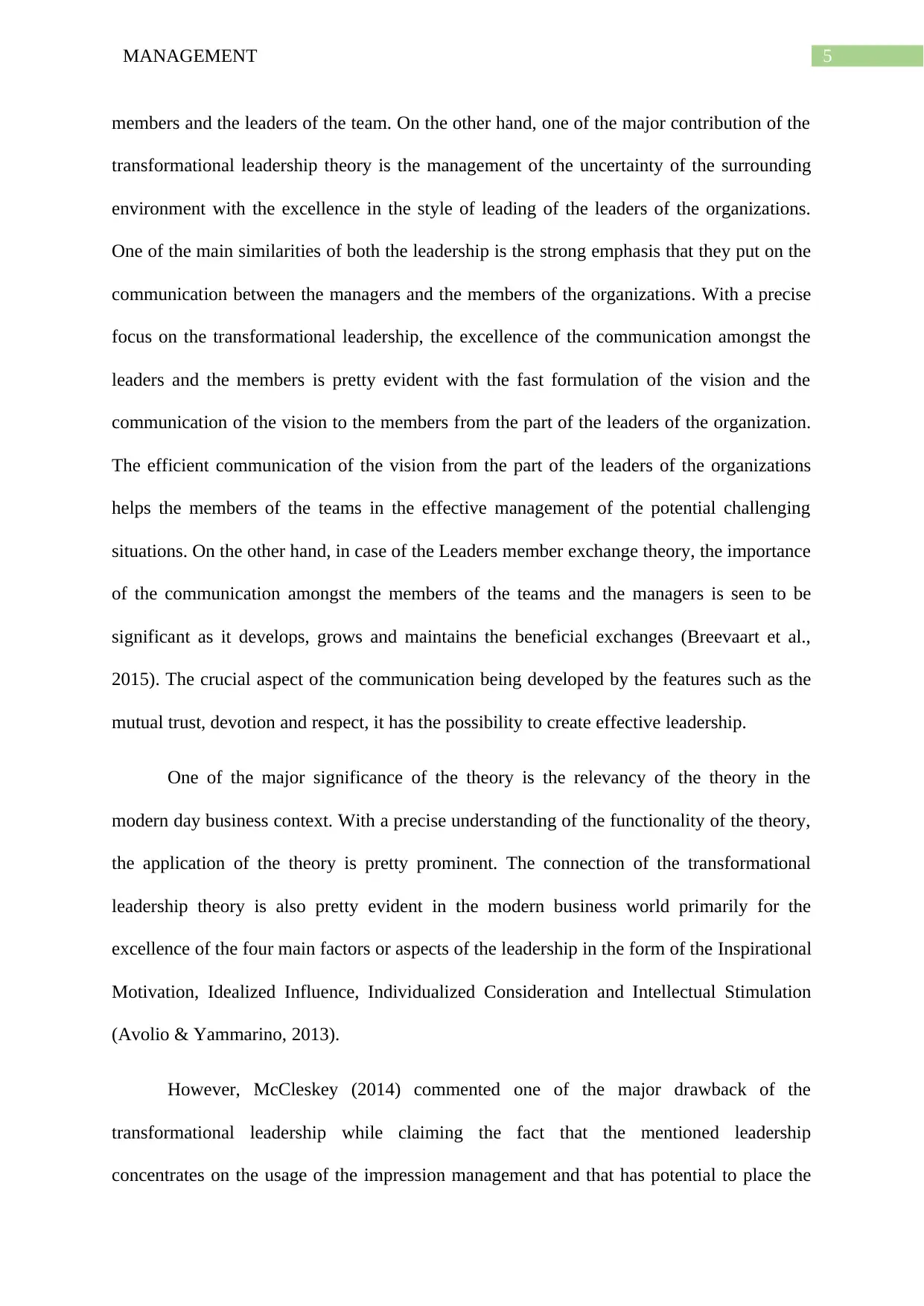
5MANAGEMENT
members and the leaders of the team. On the other hand, one of the major contribution of the
transformational leadership theory is the management of the uncertainty of the surrounding
environment with the excellence in the style of leading of the leaders of the organizations.
One of the main similarities of both the leadership is the strong emphasis that they put on the
communication between the managers and the members of the organizations. With a precise
focus on the transformational leadership, the excellence of the communication amongst the
leaders and the members is pretty evident with the fast formulation of the vision and the
communication of the vision to the members from the part of the leaders of the organization.
The efficient communication of the vision from the part of the leaders of the organizations
helps the members of the teams in the effective management of the potential challenging
situations. On the other hand, in case of the Leaders member exchange theory, the importance
of the communication amongst the members of the teams and the managers is seen to be
significant as it develops, grows and maintains the beneficial exchanges (Breevaart et al.,
2015). The crucial aspect of the communication being developed by the features such as the
mutual trust, devotion and respect, it has the possibility to create effective leadership.
One of the major significance of the theory is the relevancy of the theory in the
modern day business context. With a precise understanding of the functionality of the theory,
the application of the theory is pretty prominent. The connection of the transformational
leadership theory is also pretty evident in the modern business world primarily for the
excellence of the four main factors or aspects of the leadership in the form of the Inspirational
Motivation, Idealized Influence, Individualized Consideration and Intellectual Stimulation
(Avolio & Yammarino, 2013).
However, McCleskey (2014) commented one of the major drawback of the
transformational leadership while claiming the fact that the mentioned leadership
concentrates on the usage of the impression management and that has potential to place the
members and the leaders of the team. On the other hand, one of the major contribution of the
transformational leadership theory is the management of the uncertainty of the surrounding
environment with the excellence in the style of leading of the leaders of the organizations.
One of the main similarities of both the leadership is the strong emphasis that they put on the
communication between the managers and the members of the organizations. With a precise
focus on the transformational leadership, the excellence of the communication amongst the
leaders and the members is pretty evident with the fast formulation of the vision and the
communication of the vision to the members from the part of the leaders of the organization.
The efficient communication of the vision from the part of the leaders of the organizations
helps the members of the teams in the effective management of the potential challenging
situations. On the other hand, in case of the Leaders member exchange theory, the importance
of the communication amongst the members of the teams and the managers is seen to be
significant as it develops, grows and maintains the beneficial exchanges (Breevaart et al.,
2015). The crucial aspect of the communication being developed by the features such as the
mutual trust, devotion and respect, it has the possibility to create effective leadership.
One of the major significance of the theory is the relevancy of the theory in the
modern day business context. With a precise understanding of the functionality of the theory,
the application of the theory is pretty prominent. The connection of the transformational
leadership theory is also pretty evident in the modern business world primarily for the
excellence of the four main factors or aspects of the leadership in the form of the Inspirational
Motivation, Idealized Influence, Individualized Consideration and Intellectual Stimulation
(Avolio & Yammarino, 2013).
However, McCleskey (2014) commented one of the major drawback of the
transformational leadership while claiming the fact that the mentioned leadership
concentrates on the usage of the impression management and that has potential to place the
⊘ This is a preview!⊘
Do you want full access?
Subscribe today to unlock all pages.

Trusted by 1+ million students worldwide
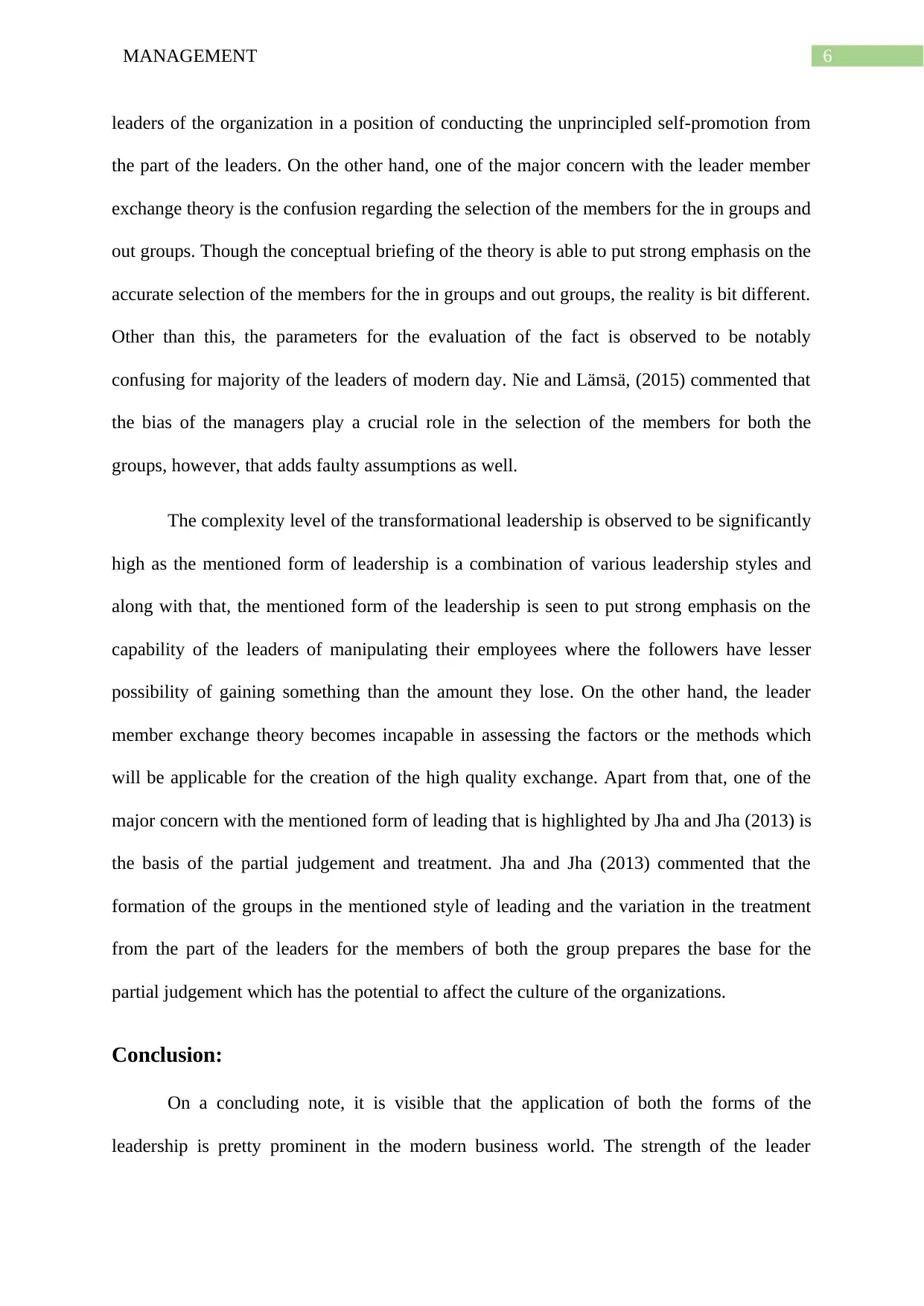
6MANAGEMENT
leaders of the organization in a position of conducting the unprincipled self-promotion from
the part of the leaders. On the other hand, one of the major concern with the leader member
exchange theory is the confusion regarding the selection of the members for the in groups and
out groups. Though the conceptual briefing of the theory is able to put strong emphasis on the
accurate selection of the members for the in groups and out groups, the reality is bit different.
Other than this, the parameters for the evaluation of the fact is observed to be notably
confusing for majority of the leaders of modern day. Nie and Lämsä, (2015) commented that
the bias of the managers play a crucial role in the selection of the members for both the
groups, however, that adds faulty assumptions as well.
The complexity level of the transformational leadership is observed to be significantly
high as the mentioned form of leadership is a combination of various leadership styles and
along with that, the mentioned form of the leadership is seen to put strong emphasis on the
capability of the leaders of manipulating their employees where the followers have lesser
possibility of gaining something than the amount they lose. On the other hand, the leader
member exchange theory becomes incapable in assessing the factors or the methods which
will be applicable for the creation of the high quality exchange. Apart from that, one of the
major concern with the mentioned form of leading that is highlighted by Jha and Jha (2013) is
the basis of the partial judgement and treatment. Jha and Jha (2013) commented that the
formation of the groups in the mentioned style of leading and the variation in the treatment
from the part of the leaders for the members of both the group prepares the base for the
partial judgement which has the potential to affect the culture of the organizations.
Conclusion:
On a concluding note, it is visible that the application of both the forms of the
leadership is pretty prominent in the modern business world. The strength of the leader
leaders of the organization in a position of conducting the unprincipled self-promotion from
the part of the leaders. On the other hand, one of the major concern with the leader member
exchange theory is the confusion regarding the selection of the members for the in groups and
out groups. Though the conceptual briefing of the theory is able to put strong emphasis on the
accurate selection of the members for the in groups and out groups, the reality is bit different.
Other than this, the parameters for the evaluation of the fact is observed to be notably
confusing for majority of the leaders of modern day. Nie and Lämsä, (2015) commented that
the bias of the managers play a crucial role in the selection of the members for both the
groups, however, that adds faulty assumptions as well.
The complexity level of the transformational leadership is observed to be significantly
high as the mentioned form of leadership is a combination of various leadership styles and
along with that, the mentioned form of the leadership is seen to put strong emphasis on the
capability of the leaders of manipulating their employees where the followers have lesser
possibility of gaining something than the amount they lose. On the other hand, the leader
member exchange theory becomes incapable in assessing the factors or the methods which
will be applicable for the creation of the high quality exchange. Apart from that, one of the
major concern with the mentioned form of leading that is highlighted by Jha and Jha (2013) is
the basis of the partial judgement and treatment. Jha and Jha (2013) commented that the
formation of the groups in the mentioned style of leading and the variation in the treatment
from the part of the leaders for the members of both the group prepares the base for the
partial judgement which has the potential to affect the culture of the organizations.
Conclusion:
On a concluding note, it is visible that the application of both the forms of the
leadership is pretty prominent in the modern business world. The strength of the leader
Paraphrase This Document
Need a fresh take? Get an instant paraphrase of this document with our AI Paraphraser
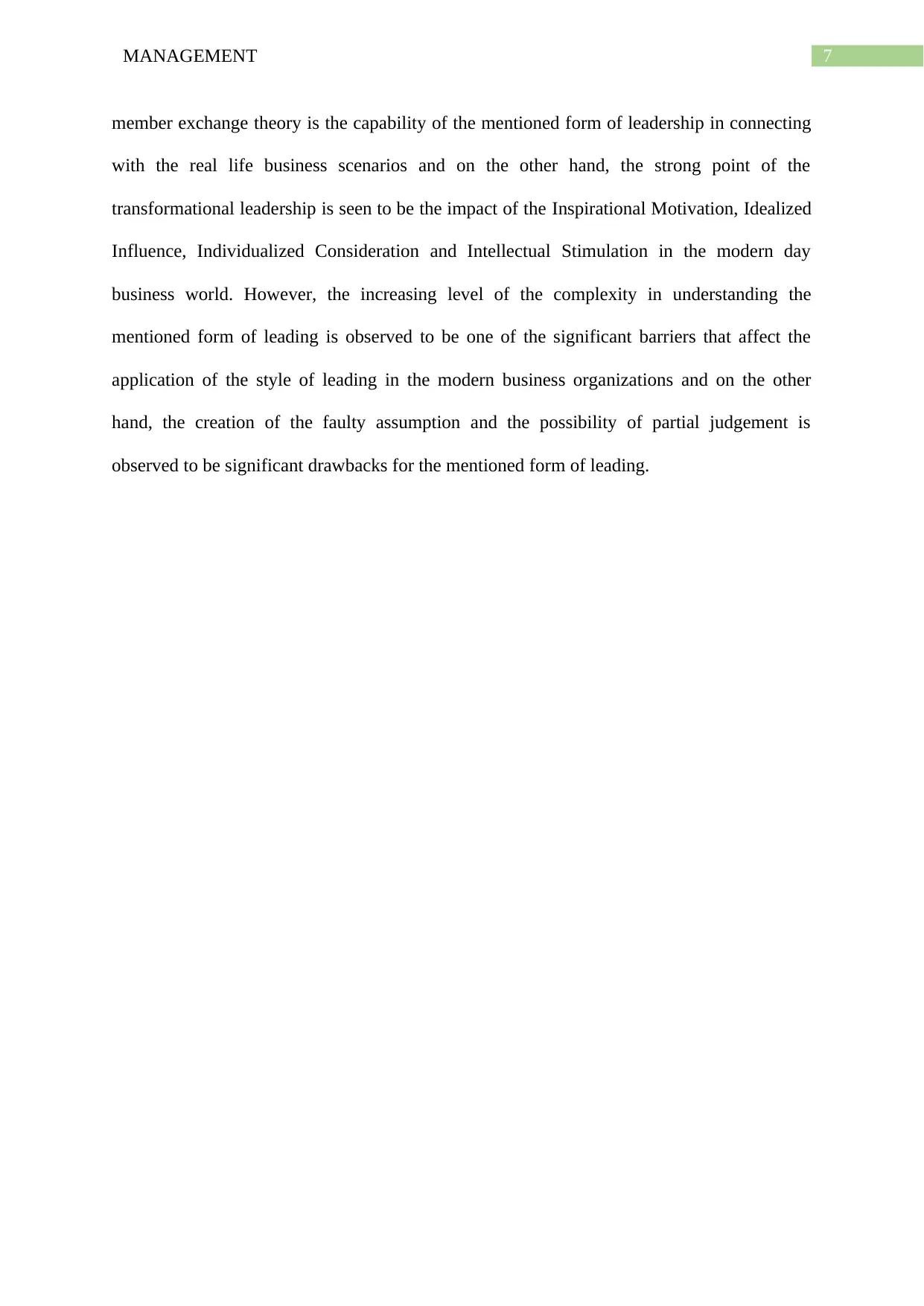
7MANAGEMENT
member exchange theory is the capability of the mentioned form of leadership in connecting
with the real life business scenarios and on the other hand, the strong point of the
transformational leadership is seen to be the impact of the Inspirational Motivation, Idealized
Influence, Individualized Consideration and Intellectual Stimulation in the modern day
business world. However, the increasing level of the complexity in understanding the
mentioned form of leading is observed to be one of the significant barriers that affect the
application of the style of leading in the modern business organizations and on the other
hand, the creation of the faulty assumption and the possibility of partial judgement is
observed to be significant drawbacks for the mentioned form of leading.
member exchange theory is the capability of the mentioned form of leadership in connecting
with the real life business scenarios and on the other hand, the strong point of the
transformational leadership is seen to be the impact of the Inspirational Motivation, Idealized
Influence, Individualized Consideration and Intellectual Stimulation in the modern day
business world. However, the increasing level of the complexity in understanding the
mentioned form of leading is observed to be one of the significant barriers that affect the
application of the style of leading in the modern business organizations and on the other
hand, the creation of the faulty assumption and the possibility of partial judgement is
observed to be significant drawbacks for the mentioned form of leading.
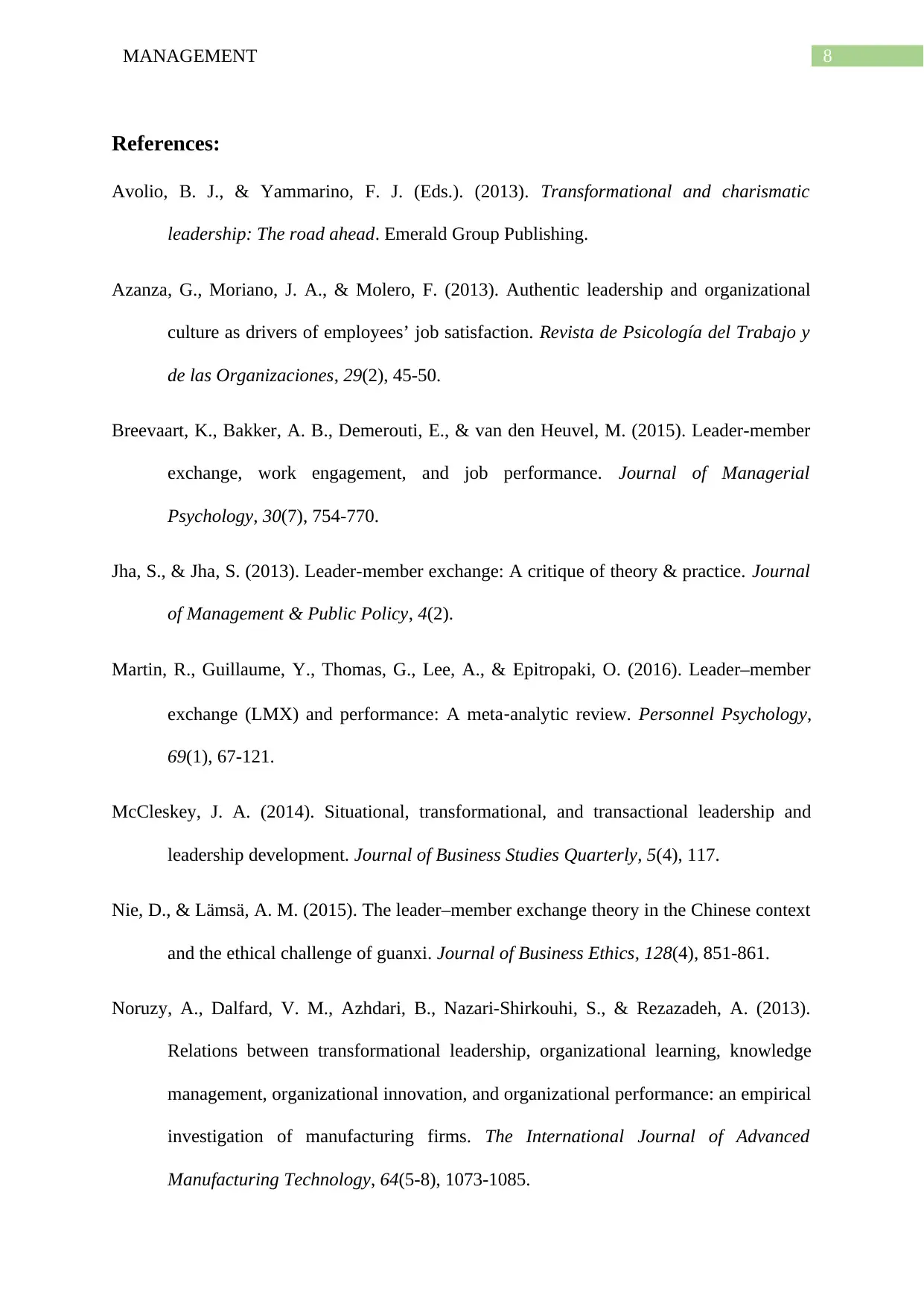
8MANAGEMENT
References:
Avolio, B. J., & Yammarino, F. J. (Eds.). (2013). Transformational and charismatic
leadership: The road ahead. Emerald Group Publishing.
Azanza, G., Moriano, J. A., & Molero, F. (2013). Authentic leadership and organizational
culture as drivers of employees’ job satisfaction. Revista de Psicología del Trabajo y
de las Organizaciones, 29(2), 45-50.
Breevaart, K., Bakker, A. B., Demerouti, E., & van den Heuvel, M. (2015). Leader-member
exchange, work engagement, and job performance. Journal of Managerial
Psychology, 30(7), 754-770.
Jha, S., & Jha, S. (2013). Leader-member exchange: A critique of theory & practice. Journal
of Management & Public Policy, 4(2).
Martin, R., Guillaume, Y., Thomas, G., Lee, A., & Epitropaki, O. (2016). Leader–member
exchange (LMX) and performance: A meta‐analytic review. Personnel Psychology,
69(1), 67-121.
McCleskey, J. A. (2014). Situational, transformational, and transactional leadership and
leadership development. Journal of Business Studies Quarterly, 5(4), 117.
Nie, D., & Lämsä, A. M. (2015). The leader–member exchange theory in the Chinese context
and the ethical challenge of guanxi. Journal of Business Ethics, 128(4), 851-861.
Noruzy, A., Dalfard, V. M., Azhdari, B., Nazari-Shirkouhi, S., & Rezazadeh, A. (2013).
Relations between transformational leadership, organizational learning, knowledge
management, organizational innovation, and organizational performance: an empirical
investigation of manufacturing firms. The International Journal of Advanced
Manufacturing Technology, 64(5-8), 1073-1085.
References:
Avolio, B. J., & Yammarino, F. J. (Eds.). (2013). Transformational and charismatic
leadership: The road ahead. Emerald Group Publishing.
Azanza, G., Moriano, J. A., & Molero, F. (2013). Authentic leadership and organizational
culture as drivers of employees’ job satisfaction. Revista de Psicología del Trabajo y
de las Organizaciones, 29(2), 45-50.
Breevaart, K., Bakker, A. B., Demerouti, E., & van den Heuvel, M. (2015). Leader-member
exchange, work engagement, and job performance. Journal of Managerial
Psychology, 30(7), 754-770.
Jha, S., & Jha, S. (2013). Leader-member exchange: A critique of theory & practice. Journal
of Management & Public Policy, 4(2).
Martin, R., Guillaume, Y., Thomas, G., Lee, A., & Epitropaki, O. (2016). Leader–member
exchange (LMX) and performance: A meta‐analytic review. Personnel Psychology,
69(1), 67-121.
McCleskey, J. A. (2014). Situational, transformational, and transactional leadership and
leadership development. Journal of Business Studies Quarterly, 5(4), 117.
Nie, D., & Lämsä, A. M. (2015). The leader–member exchange theory in the Chinese context
and the ethical challenge of guanxi. Journal of Business Ethics, 128(4), 851-861.
Noruzy, A., Dalfard, V. M., Azhdari, B., Nazari-Shirkouhi, S., & Rezazadeh, A. (2013).
Relations between transformational leadership, organizational learning, knowledge
management, organizational innovation, and organizational performance: an empirical
investigation of manufacturing firms. The International Journal of Advanced
Manufacturing Technology, 64(5-8), 1073-1085.
⊘ This is a preview!⊘
Do you want full access?
Subscribe today to unlock all pages.

Trusted by 1+ million students worldwide
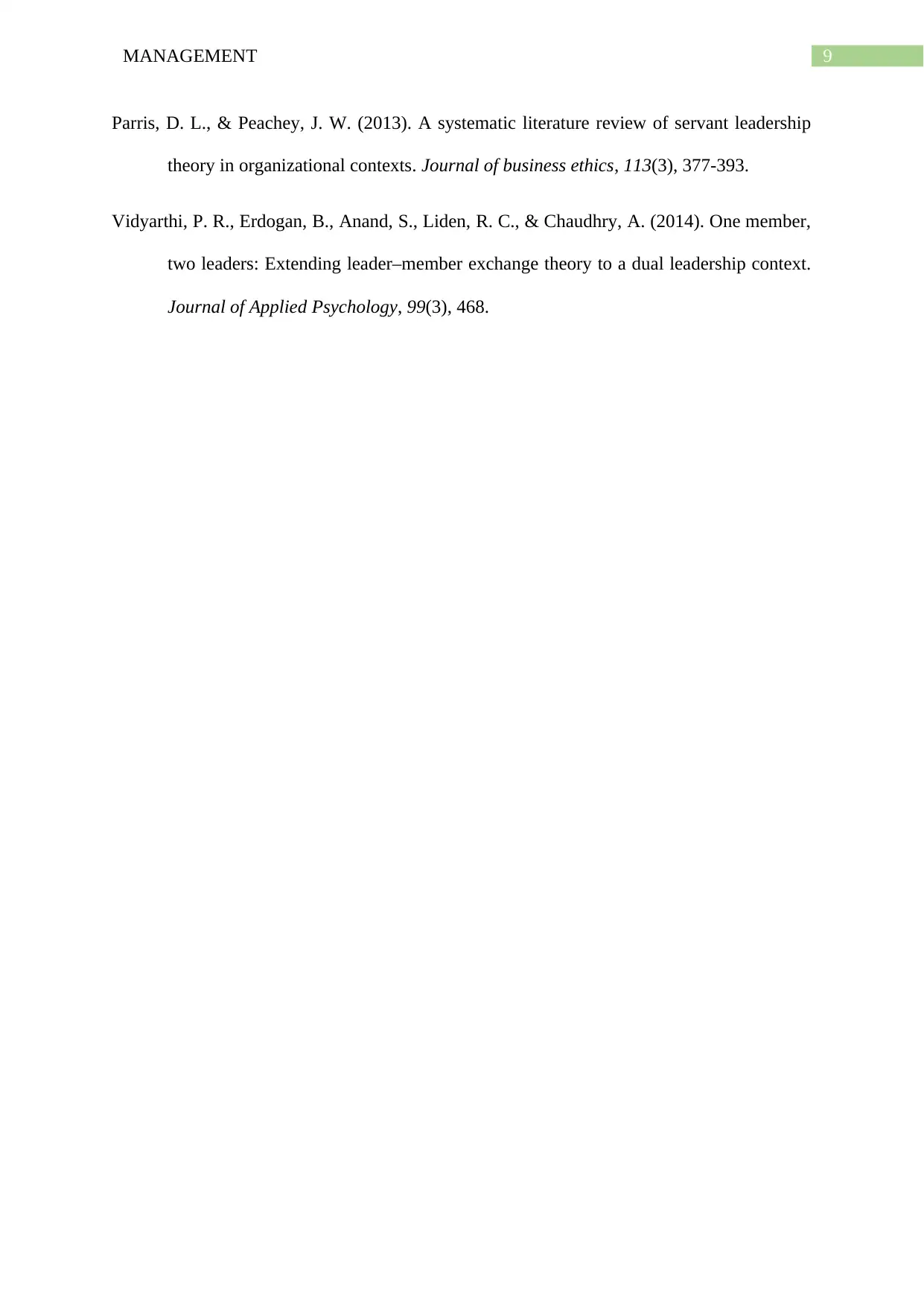
9MANAGEMENT
Parris, D. L., & Peachey, J. W. (2013). A systematic literature review of servant leadership
theory in organizational contexts. Journal of business ethics, 113(3), 377-393.
Vidyarthi, P. R., Erdogan, B., Anand, S., Liden, R. C., & Chaudhry, A. (2014). One member,
two leaders: Extending leader–member exchange theory to a dual leadership context.
Journal of Applied Psychology, 99(3), 468.
Parris, D. L., & Peachey, J. W. (2013). A systematic literature review of servant leadership
theory in organizational contexts. Journal of business ethics, 113(3), 377-393.
Vidyarthi, P. R., Erdogan, B., Anand, S., Liden, R. C., & Chaudhry, A. (2014). One member,
two leaders: Extending leader–member exchange theory to a dual leadership context.
Journal of Applied Psychology, 99(3), 468.
1 out of 10
Related Documents
Your All-in-One AI-Powered Toolkit for Academic Success.
+13062052269
info@desklib.com
Available 24*7 on WhatsApp / Email
![[object Object]](/_next/static/media/star-bottom.7253800d.svg)
Unlock your academic potential
Copyright © 2020–2025 A2Z Services. All Rights Reserved. Developed and managed by ZUCOL.



